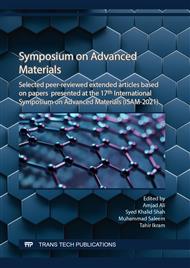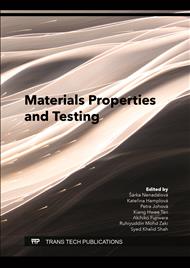[1]
E. Matin, M.M. Attar, B. Ramezanzadeh, Investigation of corrosion protection properties of an epoxy nanocomposite loaded with polysiloxane surface modified nanosilica particles on the steel substrate, Prog. Org. Coatings, 78 (2015) 395–403.
DOI: 10.1016/j.porgcoat.2014.07.004
Google Scholar
[2]
P. Roberge, Handbook of corrosion engineering, Choice Rev. Online, 37 (2000) 37-5122-37–5122.
DOI: 10.5860/choice.37-5122
Google Scholar
[3]
X. Wang, Z. Lin, Robust, hydrophobic anti-corrosion coating prepared by PDMS modified epoxy composite with graphite nanoplatelets/nano-silica hybrid nanofillers, Surf. Coatings Technol., 421 (2021).
DOI: 10.1016/j.surfcoat.2021.127440
Google Scholar
[4]
M. Arun, S. Kantheti, R.R. Gaddam, R. Narayan, K.V.S.N. Raju, Surface modification of TiO2 nanoparticles with 1,3,5-triazine based silane coupling agent and its cumulative effect on the properties of polyurethane composite coating, J. Polym. Res., 21 (2014).
DOI: 10.1007/s10965-014-0600-7
Google Scholar
[5]
H. Leidheiser, CORROSION OF PAINTED METALS - A REVIEW, Corrosion, 38 (1982) 374–383.
DOI: 10.5006/1.3581899
Google Scholar
[6]
Y. González-García, S. González, R.M. Souto, Electrochemical and structural properties of a polyurethane coating on steel substrates for corrosion protection, Corros. Sci., 49 (2007) 3514–3526.
DOI: 10.1016/j.corsci.2007.03.018
Google Scholar
[7]
G.W. Walter, A critical review of the protection of metals by paints, Corros. Sci., 26 (1986) 27–38.
Google Scholar
[8]
E.P.M. van Westing, G.M. Ferrari, J.H.W. de Wit, The determination of coating performance with impedance measurements-II Water uptake of coatings, Corros. Sci., 36 (1994) 957–977.
DOI: 10.1016/0010-938x(94)90197-x
Google Scholar
[9]
M.M. Popović, B.N. Grgur, V.B. Mišković-Stanković, Corrosion studies on electrochemically deposited PANI and PANI/epoxy coatings on mild steel in acid sulfate solution, in: Prog. Org. Coatings, 2005: p.359–365.
DOI: 10.1016/j.porgcoat.2004.05.009
Google Scholar
[10]
M. Barletta, L. Lusvarghi, F.P. Mantini, G. Rubino, Epoxy-based thermosetting powder coatings: Surface appearance, scratch adhesion and wear resistance, Surf. Coatings Technol., 201 (2007) 7479–7504.
DOI: 10.1016/j.surfcoat.2007.02.017
Google Scholar
[11]
B. Qi, T.P. Yao, Y.D. Zhang, H.K. Shang, Endowing the sustainable antistatic properties to epoxy-based composites through adding graphene nanoplatelets, J. Clean. Prod., 281 (2021).
DOI: 10.1016/j.jclepro.2020.124594
Google Scholar
[12]
D.E. Tallman, G. Spinks, A. Dominis, G.G. Wallace, Electroactive conducting polymers for corrosion control: Part 1 General introduction and a review of non-ferrous metals, J. Solid State Electrochem., 6 (2002) 73–84.
DOI: 10.1007/s100080100212
Google Scholar
[13]
S. Radhakrishnan, C.R. Siju, D. Mahanta, S. Patil, G. Madras, Conducting polyaniline-nano-TiO2 composites for smart corrosion resistant coatings, Electrochim. Acta, 54 (2009) 1249–1254.
DOI: 10.1016/j.electacta.2008.08.069
Google Scholar
[14]
N.K. Lape, E.E. Nuxoll, E.L. Cussler, Polydisperse flakes in barrier films, J. Memb. Sci., 236 (2004) 29–37.
DOI: 10.1016/j.memsci.2003.12.026
Google Scholar
[15]
M. Alexandre, P. Dubois, Polymer-layered silicate nanocomposites: Preparation, properties and uses of a new class of materials, Mater. Sci. Eng. R Reports, 28 (2000) 1–63.
DOI: 10.1016/s0927-796x(00)00012-7
Google Scholar
[16]
D.J. Chaiko, A.A. Leyva, Thermal transitions and barrier properties of olefinic nanocomposites, Chem. Mater., 17 (2005) 13–19.
DOI: 10.1021/cm0302680
Google Scholar
[17]
H. Shi, F. Liu, L. Yang, E. Han, Characterization of protective performance of epoxy reinforced with nanometer-sized TiO2 and SiO2, Prog. Org. Coatings, 62 (2008) 359–368.
DOI: 10.1016/j.porgcoat.2007.11.003
Google Scholar
[18]
X. Zhang, F. Wang, Y. Du, Effect of nano-sized titanium powder addition on corrosion performance of epoxy coatings, Surf. Coatings Technol., 201 (2007) 7241–7245.
DOI: 10.1016/j.surfcoat.2007.01.042
Google Scholar
[19]
S.K. Dhoke, A.S. Khanna, T.J.M. Sinha, Effect of nano-ZnO particles on the corrosion behavior of alkyd-based waterborne coatings,, Prog. Org. Coatings, 64 (2009) 371–382.
DOI: 10.1016/j.porgcoat.2008.07.023
Google Scholar
[20]
J. Xu, J. Tao, S. Jiang, Z. Xu, Investigation on corrosion and wear behaviors of nanoparticles reinforced Ni-based composite alloying layer, Appl. Surf. Sci., 254 (2008) 4036–4043.
DOI: 10.1016/j.apsusc.2007.12.039
Google Scholar
[21]
Trinh Anh Truc, To Thi Xuan Hang, Vu Ke Oanh, E. Dantras, C. Lacabanne, D. Oquab, N. Pébère, Incorporation of an indole-3 butyric acid modified clay in epoxy resin for corrosion protection of carbon steel, Surf. Coatings Technol., 202 (2008) 4945–4951.
DOI: 10.1016/j.surfcoat.2008.04.092
Google Scholar
[22]
R. Krishnamoorti, R.A. Vaia, Polymer nanocomposites, J. Polym. Sci. Part B Polym. Phys., 45 (2007) 3252–3256.
DOI: 10.1002/polb.21319
Google Scholar
[23]
C.H. Chang, T.C. Huang, C.W. Peng, T.C. Yeh, H.I. Lu, W.I. Hung, C.J. Weng, T.I. Yang, J.M. Yeh, Novel anticorrosion coatings prepared from polyaniline/graphene composites, Carbon N. Y., 50 (2012) 5044–5051.
DOI: 10.1016/j.carbon.2012.06.043
Google Scholar
[24]
J.R. Beryl, J.R. Xavier, A study on the anticorrosion performance of epoxy nanocomposite coatings containing epoxy-silane treated nanoclay on mild steel in chloride environment, J. Polym. Res., 28 (2021).
DOI: 10.1007/s10965-021-02512-2
Google Scholar
[25]
F. Branda, F. Tescione, V. Ambrogi, D. Sannino, B. Silvestri, G. Luciani, A. Costantini, A new extra situ sol-gel route to silica/epoxy (DGEBA) nanocomposite A DTA study of imidazole cure kinetic, Polym. Bull., 66 (2011) 1289–1300.
DOI: 10.1007/s00289-010-0429-0
Google Scholar
[26]
F. Mustata, N. Tudorachi, D. Rosu, Curing and thermal behavior of resin matrix for composites based on epoxidized soybean oil/diglycidyl ether of bisphenol A, Compos. Part B Eng., 42 (2011) 1803–1812.
DOI: 10.1016/j.compositesb.2011.07.003
Google Scholar
[27]
S. Ahmad, A.P. Gupta, E. Sharmin, M. Alam, S.K. Pandey, Synthesis, characterization and development of high performance siloxane-modified epoxy paints, Prog. Org. Coatings, 54 (2005) 248–255.
DOI: 10.1016/j.porgcoat.2005.06.013
Google Scholar
[28]
H. Shi, F. Liu, L. Yang, E. Han, Characterization of protective performance of epoxy reinforced with nanometer-sized TiO2 and SiO2, Prog. Org. Coatings, 62 (2008) 359–368.
DOI: 10.1016/j.porgcoat.2007.11.003
Google Scholar
[29]
E. Bakhshandeh, A. Jannesari, Z. Ranjbar, S. Sobhani, M.R. Saeb, Anti-corrosion hybrid coatings based on epoxy-silica nano-composites: Toward relationship between the morphology and EIS data, Prog. Org. Coatings, 77 (2014) 1169–1183.
DOI: 10.1016/j.porgcoat.2014.04.005
Google Scholar
[30]
R.A. Dubois, P.S. Sheih, Fundamental studies of epoxy resins for can and coil coatings III Effect of bisphenol structure on resin and coating flexibility, J. Coatings Technol., 64 (1992) 51–57.
Google Scholar
[31]
M.T. Rodríguez, J.J. Gracenea, S.J. García, J.J. Saura, J.J. Suay, Testing the influence of the plasticizers addition on the anticorrosive properties of an epoxy primer by means of electrochemical techniques, Prog. Org. Coatings, 50 (2004) 123–131.
DOI: 10.1016/j.porgcoat.2004.01.003
Google Scholar
[32]
S.J. García, J. Suay, Epoxy powder clearcoats used for anticorrosive purposes cured with ytterbium III trifluoromethanesulfonate, Corrosion, 63 (2007) 379–390.
DOI: 10.5006/1.3278391
Google Scholar
[33]
G. Ruhi, H. Bhandari, S.K. Dhawan, Designing of corrosion resistant epoxy coatings embedded with polypyrrole/SiO2 composite, Prog. Org. Coatings, 77 (2014) 1484–1498.
DOI: 10.1016/j.porgcoat.2014.04.013
Google Scholar
[34]
E. Armelin, R. Pla, F. Liesa, X. Ramis, J.I. Iribarren, C. Alemán, Corrosion protection with polyaniline and polypyrrole as anticorrosive additives for epoxy paint, Corros. Sci., 50 (2008) 721–728.
DOI: 10.1016/j.corsci.2007.10.006
Google Scholar
[35]
S. Radhakrishnan, N. Sonawane, C.R. Siju, Epoxy powder coatings containing polyaniline for enhanced corrosion protection, Prog. Org. Coatings, 64 (2009) 383–386.
DOI: 10.1016/j.porgcoat.2008.07.024
Google Scholar
[36]
S.H. Ahn, S.H. Kim, S.G. Lee, Surface-modified silica nanoparticle-reinforced poly(ethylene 2,6-naphthalate), J. Appl. Polym. Sci., 94 (2004) 812–818.
DOI: 10.1002/app.21007
Google Scholar
[37]
J. Choi, A.F. Yee, R.M. Laine, Organic/inorganic hybrid composites from cubic silsesquioxanes Epoxy resins of octa(dimethylsiloxyethylcyclohexylepoxide) silsesquioxane, Macromolecules, 36 (2003) 5666–5682.
DOI: 10.1021/ma030172r
Google Scholar
[38]
J.M. Yeh, C.L. Chen, Y.C. Chen, C.Y. Ma, H.Y. Huang, Y.H. Yu, Enhanced Corrosion Prevention Effect of Polysulfone-Clay Nanocomposite Materials Prepared by Solution Dispersion, J. Appl. Polym. Sci., 92 (2004) 631–637.
DOI: 10.1002/app.13435
Google Scholar
[39]
D. Tiab, E.C. Donaldson, Wettability, Petrophysics, (2012) 371–418.
DOI: 10.1016/b978-0-12-383848-3.00006-2
Google Scholar
[40]
M. Moradi Kooshksara, S. Mohammadi, Investigation of the in-situ solvothermal reduction of multi-layered Graphene oxide in epoxy coating by acetonitrile on improving the hydrophobicity and corrosion resistance, Prog. Org. Coatings, 159 (2021).
DOI: 10.1016/j.porgcoat.2021.106432
Google Scholar



